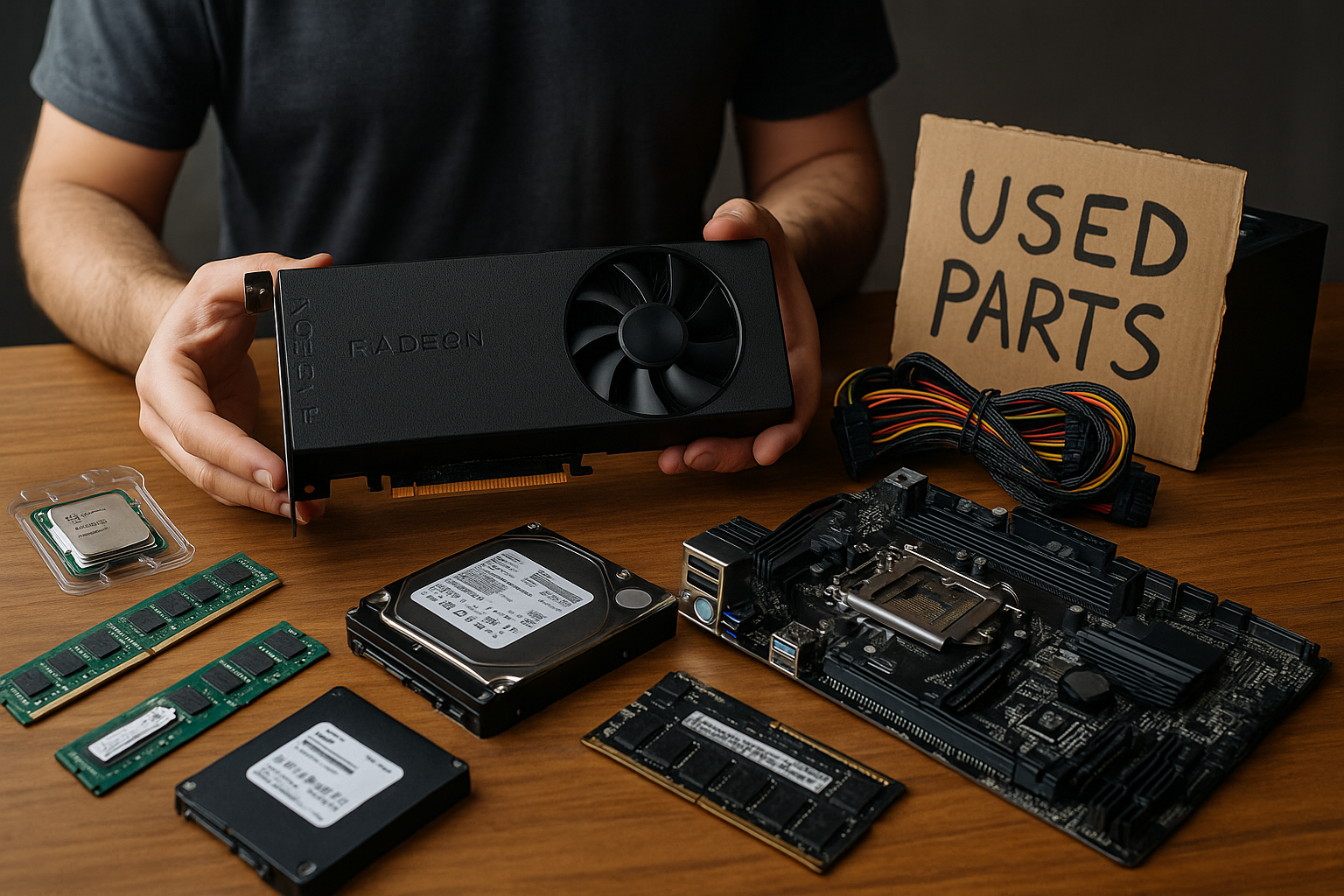When building a computer, especially on a tight budget, many people consider using second-hand or refurbished components. The idea of saving a significant amount of money is tempting—but is it a good move? Are used PC parts reliable, or are you setting yourself up for failure?
In this article, we’ll explore the pros and cons of buying used PC parts, which components are generally safe to buy second-hand, what to avoid, and how to minimize risk.
Why Consider Used PC Parts?
The main appeal of buying used parts is cost savings. You can often find components 30% to 70% cheaper than their retail price. For example:
- A used graphics card might cost $150 instead of $300.
- A second-hand CPU cooler might be available for $20 instead of $60.
Used parts are also a smart way to:
- Upgrade an old system on a budget
- Access discontinued but powerful hardware
- Reuse quality parts from older builds
The Risks of Buying Used Components
While buying used can be a great way to save, it comes with risks that you should consider:
1. No Warranty
- Most used components are sold “as-is” with no return policy.
- If something fails, you may not be able to get a replacement or refund.
2. Hidden Damage
- Components may look good externally but have unseen damage (e.g., burned circuits, bent pins).
3. Overuse or Overclocking
- The part may have been used under heavy load 24/7.
- Overclocked parts may degrade faster over time.
4. Scams and Fakes
- Sellers might send broken or counterfeit products, especially in online marketplaces.
Best Places to Buy Used PC Parts
Not all platforms are equal. Here are the most common and safest places to shop:
✅ Recommended:
- eBay: Buyer protection and refund policies.
- Reddit Hardware Swap: Community-vetted sellers.
- Facebook Marketplace: Good for local pickup and inspection.
- Trusted local computer shops: Offer refurbished components with warranties.
❌ Riskier:
- Random sellers on AliExpress or Wish.
- Classified ads with little seller info.
- New accounts with no feedback.
Always look for seller ratings, photos, receipts, and test results.
Which Used Parts Are Generally Safe to Buy?
1. CPUs
- CPUs are very durable and often outlive other components.
- Just make sure the pins aren’t bent (for AMD) and that the seller didn’t overclock excessively.
2. Cases
- Great item to buy used—there’s little that can go wrong.
- Check for missing screws or broken USB ports.
3. RAM
- RAM sticks are resilient. If they work, they usually keep working.
- Look for modules from reliable brands (Corsair, G.Skill, Crucial).
4. Coolers (Air or AIO)
- Air coolers last a long time; just clean the dust.
- With AIO liquid coolers, ensure the pump still works and there’s no leakage.
5. Hard Drives (HDD)
- Acceptable if they have low hours and no bad sectors.
- Ask for a CrystalDiskInfo report or test it yourself.
Used Parts to Be Careful With
1. Graphics Cards (GPUs)
- Frequently overused or mined on.
- May have been tampered with or repaired improperly.
- Ask for benchmarks or testing screenshots.
2. Power Supplies (PSUs)
- Internal components degrade over time.
- Failure can damage your entire system.
- Only buy if:
- It’s from a reputable brand
- It’s still under warranty
- It hasn’t been used 24/7 in mining or servers
Parts You Should Avoid Buying Used
1. Motherboards
- Difficult to test properly without assembling a full PC.
- Issues may not show up until weeks later.
- BIOS updates or damaged pins can lead to unpredictable errors.
2. Fans or RGB Accessories
- These are usually cheap when new.
- Used fans can be noisy or have worn-out bearings.
3. SSD (especially QLC or TLC-based)
- SSDs have a limited number of write cycles.
- Sellers might not disclose how many TB have already been written.
- Prefer new SSDs unless usage history is verifiable.
How to Safely Buy Used Parts
✅ Checklist:
- Ask for photos from multiple angles.
- Request proof of functionality (screenshots, test logs, video of the part running).
- Ask about:
- Original purchase date
- Usage history (e.g., gaming vs. mining)
- Overclocking history
- Meet in public if buying locally.
- Test the part immediately after purchase.
If you’re buying online, pay with PayPal Goods & Services or another method with buyer protection.
Refurbished vs. Used
Refurbished parts are typically tested and restored by a seller or manufacturer, often with a limited warranty.
Pros of Refurbished:
- Cheaper than new
- Some warranty
- Professionally cleaned and tested
Pros of Used:
- Even cheaper
- Larger variety
- More flexible (e.g., buy parts from personal sellers)
Whenever possible, refurbished parts from trusted vendors (e.g., Newegg, Amazon Renewed) are a safer middle ground.
Is It Worth It?
The answer is: Yes, it can be—but only if you’re careful.
Buying used can help you:
- Build a PC on a tighter budget
- Access discontinued high-performance parts
- Extend the life of an older system
However, you need to research sellers, test thoroughly, and avoid high-risk components like motherboards or power supplies without warranty.
Final Thoughts: Smart Savings or Costly Gamble?
Buying used PC parts is like buying a used car—it can be a bargain or a headache depending on how it was treated and how well you check it out.
Our Advice:
- Stick with durable parts like CPUs, RAM, and cases.
- Be extra cautious with GPUs and PSUs.
- Avoid used motherboards unless you can test them fully.
- Buy only from trusted sources and always test as soon as possible.
With smart decisions, used PC parts can offer excellent value—and help you build or upgrade a system without breaking the bank.
